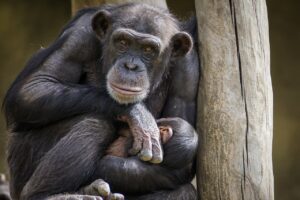In 1942, a little girl named Jane Goodall received a copy of The Story of Doctor Dolittle by Hugh Lofting. Her favorite part of the book was an illustration of a monkey crossing a bridge that Dr. Doolittle had built in the forest. From that moment, the idea of going to Africa and watching wild animals enamoured and absorbed her.
In July 1960, Jane and her mother arrive at Gombe Reserve in Tanzania. By 1961, she has observed the chimpanzees using sticks as tools to extract termites from their mounds for eating. She also reports clear evidence of them showing intelligence, unique personalities and emotions. The scientific community is less than enthusiastic. Creating and using tools is the distinctive and dividing characteristic that separates humans from all other living things–never mind showing emotion and exhibiting unique personality traits.
It is challenging to live, on her own, in the Gombe Reserve with just the chimpanzees as company. It is even more challenging to work with a scientific community that had been seriously opposed to her and her work ever since Cambridge University accepts her as a PhD candidate in 1962 when she had no complete undergraduate degree. Living with chimpanzees would make it difficult to live with people, especially educated people.
At a conference in Chicago in the mid-1980’s the destruction of the forest caused by human migration, logging and other activities becomes apparent to Jane, prompting her to find ways of working with the local people and the global corporations to stop the destruction.
This leads to two initiatives. In 1991, Jane and her team start an educational program for local youths and community members called Roots and Shoots. Among its many goals is building green, land bridges connecting healthy parts of the forest across burned over sections to other green and thriving forest. These bridges would allow chimpanzee colonies in one isolated area to move to and breed with members of other chimpanzee communities, isolated by the logging and burning and keep the gene pool healthy.
In 1992, Jane made the tough decision to reach out to Conoco, an oil company drilling for oil in the Congo. Because of her efforts, Conoco agreed to two things. First, they would speed up approaches to find and drill for oil that was less environmentally hostile. Second, Conoco would build, with Jane, and at their cost a refuge in that country, for chimpanzees rescued from zoos and the meat and other animal trades in central Africa.
It enraged animal rights activists that she would work with an oil company to save the chimpanzees. Jane pointed out that she had never had success, whether working with academics, oil companies, local peoples or governments when she got emotional and hostile. She had to work with those people or groups that seemed opposed to her overarching goals.
In a recent documentary, filmed by her decades long friends at National Geographic, Jane points out that she realized early on that she had to work with groups all over the world to save her chimps. After the experience in Chicago, she also realized that to save her chimpanzees, she also needed to save their environment. Building green bridges connecting the small islands of chimpanzees in Tanzania has helped her and the local people turn those bridges into much larger patches of green forest, slowly recovering dead forest, lost to logging and burning.
Now in her late 80s Jane still travels the world, sometimes speaking at over 300 events every year on behalf of her chimpanzees, her projects, and the world we all share. Roots and Shoots have grown into an organization for youth with hundreds of thousands of active and passionate members in over 100 countries. The group of people, young and old, global and local, academic and not formally educated, business and activists that have joined with Jane is monumental. Deciding to work with others, even those many thought to be her enemies, has allowed Jane Goodall to create a force for good–building bridges that bring people together. And it all started with a picture in a book of a chimpanzee–crossing a bridge.



